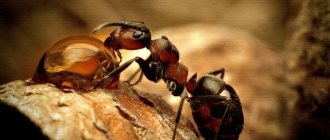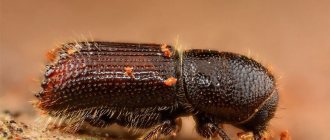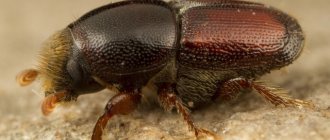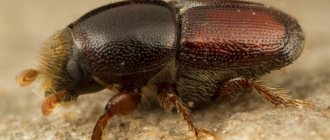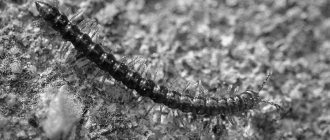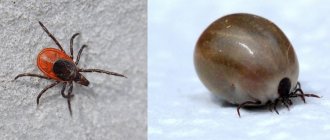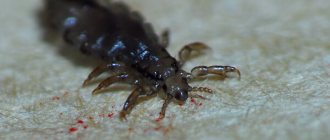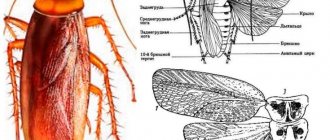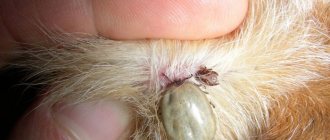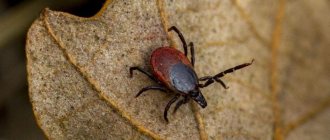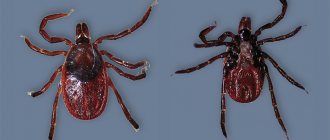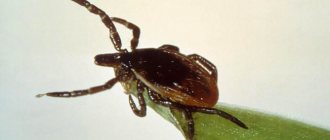Ticks belong to the order of arthropods and with the arrival of warmer weather they begin to cause great trouble for people living in private houses and those who like to relax in nature. Temperature, air humidity and the amount of food play a big role in the reproduction of ticks. If the female cannot find prey and satisfy her hunger, she will not lay eggs.
The vitality of ticks is amazing; they are able to survive the harshest winter and wait for their prey for several months without food.
The greatest activity of ticks occurs in mid-spring and early summer; during this period, the tick fertilizes several females, after which it dies, and the female tick begins to wait for its victim.
How do ticks reproduce?
After the tick has fertilized the female, it dies. The female finds the victim and sucks blood for 6-9 days until completely saturated, after which she independently falls away from the victim. A month after saturation, the female is ready to lay 1.5-6 thousand eggs. Females lay eggs on the ground and leaves in shaded and moist places.
The hatched larvae must find food for themselves by attaching to the victim for up to 5 days, after which they fall off and continue to develop. This process is repeated several times until the tick becomes an adult (adult).
The larvae can remain in their previous form for a long time if they do not find prey for food. A tick can develop from larva to adult within several years, and in very unsuitable conditions even up to 7 years.
Life cycle features
The life cycle refers to the entire period of development and life of an organism - in this case, from egg to adult sexually mature individual. The life cycle of encephalitis ticks is quite complex, characterized by a change of hosts and lasts more than 1 year. It consists of an egg, larva, nymph and adult (imago).
Let's begin the description of the life and reproduction of ticks with the meeting of the sexes. A male and a female are usually found in nature, much less often on a host. The latter is less typical, since the chances of 2 ticks parasitizing 1 organism are relatively low.
Once the male finds the female, fertilization occurs. The mechanism of seed transfer is interesting. No copulation or intercourse occurs. The male leaves a kind of sac with spermatozoa (spermatophore) on the substrate, which protects the sperm from external factors. The female crawls up to the capsule and grabs it with special valves located near the genital opening, like tweezers. This is how fertilization occurs.
On a note
Male and female ixodid ticks are easy to distinguish from each other even to the average person. If you look at a tick from above, you can see that its body is covered with a shiny, dense chitinous shield that performs a protective function. In males, this shield covers the entire back, and the body cannot stretch much when feeding. In females, the shield is smaller and covers only half of the back, which is why its body can increase in size several times.
After fertilization, females begin to actively search for prey to feed on. Ticks are characterized by so-called “gonotrophic harmony,” when the feeding process is closely related to the maturation of eggs. In simple terms, almost all the nutrients extracted from the blood will go to the development of eggs.
Accordingly, each oviposition is necessarily preceded by blood sucking. Because of this, females are very voracious - their abundant nutrition is the key to successful reproduction. Males feed less often and in much smaller quantities. In some species of ticks, the males do not feed at all and die after transferring the seed material.
This is interesting
In some species of ixodids, males do not search for victims on their own. During the sexual process, they pierce the female's integument and feed on the contents of her intestines, without causing significant damage to her. This also has little effect on egg laying.
Females suck blood for quite a long time, on average about 10 days. Soft covers provide the opportunity to consume large volumes of blood. Sometimes 20 minutes is enough for males to feed.
The female tick begins to lay eggs a week to a month after finishing feeding (the rate of egg maturation depends on external factors). Laying lasts about a month, with the tick laying eggs in small groups as it matures.
Ticks are very prolific - up to 2000 eggs can be found in their clutches. The number of eggs depends on how well-fed the female was; the factor of disturbance also plays an important role. It is also common for female ticks to provide additional food when the first one was not enough. Sometimes ticks feed directly during the period of egg laying, which naturally makes it longer.
The clutches are located either on the soil in the natural environment, or (much less often) on the host’s body, which increases the chances of future larvae feeding.
Within a month after laying, the eggs hatch into larvae. They are small and look similar to adult ticks, but there are a number of differences. The larvae have 3 pairs of walking legs (like insects) and no genital opening.
For some time after hatching from the egg, the larvae sit on the clutch, waiting for their outer covers to harden. They then scatter in search of prey.
Aggregations of larvae on clutches are known even after hardening of the integument - hungry individuals do not disperse, but wait for future prey on the surface of plants or soil. Then not one larva attaches to the host, but several at once. This weakens the immune response of the victim’s body and promotes better saturation of the larvae.
The larvae feed for 2-4 days, after which they detach from the host, or stay on it for some time, using it as a shelter. Then they return to the natural environment, where they molt into nymphs.
Tick nymphs are similar to imagoes (adults), have 4 pairs of walking legs, an oval body with dense integument, but do not yet have a genital opening.
Molting in the life cycle of these parasites can be considered a kind of diapause, during which ticks do not feed or move; complex biochemical processes occur in their body. Even after ixodids molt, they are not capable of active life for some time, because changes in the body continue.
Molting is necessary for all arthropods, since the dense chitinous exoskeleton impedes growth and development. It is during this short period of time, while the old integuments are coming off and the new ones have not yet hardened, that the growth of the body occurs. All the remaining time is spent preparing for this process.
The gradual type of development allows one to eventually begin to feed on larger prey and occupy other ecological niches - this is an important evolutionary mechanism that allows one to reduce trophic and stationary intraspecific competition, and therefore increase the population’s chances of active reproduction.
Adults do not grow; their appearance remains unchanged.
This is interesting
The shape and size of the body of adult ticks, like insects, are unchanged and are a species characteristic by which the organism can be identified. A good example is ladybugs, whose body size and number of spots remain constant and serve to identify the species.
Nymphs feed on the host for about a week, after which they leave it. After some time, they either go to winter or turn into adults. Larvae, nymphs and adults can overwinter.
There are known cases of ticks overwintering in the ears and other parts of the body of ungulates. But more often, ixodid ticks overwinter in their natural habitats: under plant dendrite, in soil, under stones and old wood, under the bark of dry trees, in mammal burrows and bird nests. Sometimes ticks remain in farmyards and outbuildings, where they are carried by pets.
In general, diapause in ixodid ticks is not obligate, that is, it is not obligatory. At sufficiently high temperatures, mites may not go into a dormant state and continue to develop indoors in winter.
Most ixodid ticks have a three-year life cycle. The general scheme looks something like this:
- Adults in spring (April-May) actively attack vertebrates. This period is characterized by the greatest dynamics of taiga and dog ticks, so you need to be especially careful when walking in nature. At the end of summer, as a rule, adults do not feed on animals. The larvae appear in the second half of summer. Regardless of whether they are full or not, they leave for the winter;
- Throughout the second year, the larvae develop and molt into nymphs. Hungry and well-fed nymphs leave for the winter;
- In the third year, the nymphs actively feed, and at the end of summer they turn into adults. In autumn, adults do not look for victims and immediately go into diapause.
Now it becomes clear why the danger of contact with ticks increases in the spring. In areas with dry, hot weather, the cycle can occur quite quickly, in 1-2 years - then the dynamics are high not only in spring, but also in autumn.
In laboratory conditions, studies have been repeatedly conducted on the duration of reproduction of ixodid ticks in general. The result was data varying over a wide range: from 200 to 2000 days (the rate of reproduction in nature falls in the middle of this range).
Thus, the life cycle of ticks is characterized not only by longevity, diapauses and molting, but also by a change of hosts, as well as alternation of parasitism with a free-living lifestyle. We will talk about the diversity of hosts further.
Why are ticks dangerous for humans?
The tick bites quite harmlessly, and its bite is not much larger than that of a mosquito, but the victim does not feel pain, since it secretes a special enzyme that anesthetizes, and the victim can detect the parasite only visually or by feeling it.
The main reason why the tick has become so dangerous for humans and other animals lies in its feeding method and ability to carry dangerous diseases. It is diseases carried by ticks that pose a threat.
These parasites carry diseases such as borreliosis, tick-borne encephalitis, relapsing tick-borne fever, and tularemia. Many of these diseases affect the human central nervous system and if treatment is not started at an early stage, the disease can be fatal.
First, the virus penetrates the skin and an incubation period begins, after which the virus enters the circulatory system and spreads throughout the body, affecting the nervous system, heart and other vital organs.
Scabies itching
Refers to sarcoptoid mites, which neglected one of the stages of development at the nymph stage. The buzzer goes through only two nymphal stages before becoming an adult.
The genital organs are located in the same place as in ixodid ticks: between the bases of the 4th pair of legs. Males mate with teleonymphs (nymph II) on the surface of the body. After mating, the male dies, and the female goes to the epidermis to make passages and lay eggs.
The lifespan of the female is up to 2 months. During this time, she lays 2-3 eggs per day in passages under the skin.
The hatched larvae burrow into the skin and undergo metamorphic changes in papules, vesicles and passages under the skin.
Reproduction of scabies is possible only on the surface of the skin. In unfavorable conditions outside, scabies mites die very quickly.
With the onset of spring across the entire vast territory of Russia, along with the joy of blossoming buds and the first snowdrops, a familiar problem appears - the ixodid tick (lat. Ixodidae). The common people have the frightening name “encephalitis”, i.e. ticks that carry encephalitis. A more correct name for several types of ticks that bother people and animals is the dog tick or forest tick. The pasture tick also belongs to this category. Ticks appear in the spring, when the snow cover has not yet completely melted, and go into hibernation in late autumn with the onset of frost. But this does not mean that they are active throughout the warm season. To understand periods of tick activity, you should turn to biology.
Habitats and times of activity
At the beginning of May and before the onset of cold weather, blood-sucking parasites await their prey in forests, steppes, and low bushes. Their activity requires high humidity and an air temperature of 20°C. Parasites lie in wait for the victim on the leaves and branches of low bushes; the most attractive places for parasites are dark places, the light to which is blocked by tall trees.
Until mid-July, bloodsuckers are very hungry and dangerous as they prepare to mate, so during this period the parasites' habitats should be avoided.
The activity cycle of these parasites can vary depending on the region and temperature in which they live; the warmer the climate, the earlier the animals awaken and mate.
Favorable conditions for reproduction
- For unhindered reproduction, parasites need favorable conditions. Moisture is very important, so the more precipitation, the more comfortable it is for them. Of course, food, so they settle closer to potential victims so that they can regularly get enough. And lastly, temperature, they cannot tolerate cold or heat, warm weather is optimal. On hot days, they hide in the thickets, where it is cool and humid.
- These conditions influence the fact that in some years their numbers drop significantly, when there is little rainfall and the weather is mostly hot and sunny. But there are years when populations increase significantly, and weather conditions contribute to this.
- It is also worth saying that natural conditions are the usual environment for these parasites. But unfortunately, they move from their usual environment to farms and pastures, and man himself is to blame for this. Because deforestation leads to mass migrations of insects. This situation is quite dangerous, especially for people and animals. After all, along with ticks come dangerous diseases, which means that there is a risk of epidemics.
Tick structure
The dimensions of the parasite do not exceed 4 mm in length in normal condition. The tick's body is teardrop-shaped with four pairs of legs. The tips of the paws have tenacious claws that allow them to move along vertical surfaces.
The upper part of the body is covered with a durable chitinous shell that protects against many dangers. The torso has high elasticity and can increase significantly during nutrition.
The oral apparatus consists of strong jaws and a double proboscis; after penetrating the skin, the jaws reliably fix the parasite. Two holes in the proboscis allow the tick to simultaneously suck blood and secrete a special substance that reduces skin sensitivity. This ability allows ticks to quietly attach themselves to human skin.
The respiratory system of parasites is interesting, since they spend a long time with their heads submerged in the body of the victim; they have to breathe through special openings (spiracles) located in the lower part of the body.
In the process of saturation with blood, the parasites increase significantly; females are the most voracious and can suck blood 120 times more than their own weight, while the body greatly increases, reaching 1-1.5 cm. The male needs less blood, so they fall off the victim after a couple of days.
Viviparous
This concept is conditional for Akari. There are only two types that have progressed to true viviparity. The rest give their bodies to feed their offspring.
After fertilization, such a viviparous female waits for the eggs to mature and dies. The death of the female occurs in the fall, and the eggs overwinter in the body of the tick. With the onset of warm weather, the eggs hatch into larvae, which “eat up” the mother for a while, while simultaneously gnawing their way to freedom. The posthumous life of viviparous females lasts only one summer.
Interesting!
Since ticks of these species emerge with food reserves available, the eggs of postmortem viviparous females contain less nutrients than those of oviparous females.
Other types of ticks preferred to do without extreme sports and lay eggs.
How to protect yourself from ticks
The most reliable way of protection is to avoid the habitats of parasites.
- To prevent parasites from reaching your skin, before going to places where bloodsuckers may live, you should dress properly and use special protective equipment.
- Clothes should have long sleeves and trousers, the neck should be covered with a collar, and the head should be covered with a hat or hood. Many people recommend wearing socks over your pants to prevent pests from getting in.
- Various preparations for parasites are divided into two groups: repellents (repel, but do not kill) and acaricides (kill parasites when they come into contact with the treated surface), there are also combined preparations that use two components.
- Repellents are less toxic; to protect against parasites, they are applied directly to the body and repel various insects and bloodsuckers for several hours.
- Acaricides are toxic drugs for humans, and they should be applied only to the outer part of clothing, after removing it from yourself. Acaricides protect for a longer period, which can reach several weeks depending on the manufacturer.
Tyrophagus
This species is no less dangerous and can cause significant damage. They live in the ground, but if the humidity is too high, they move to more comfortable conditions, namely the leaf part. Most often they take in young shoots. Signs by which infection can be determined include the bulb drying out, spots appearing on it, punctures appear on the leaves, and a brown coating forms on the bottom of the leaves.
They are combated by regulating the level of humidity using specialized means. In order to get rid of pests on the plant itself, it is treated with Fitoverm. To destroy it in the soil, it is sprinkled with a special powder, for example, use Nissoran
It is very important to comply with the storage standards for planting material. Before sending it for storage, it must be warmed up and stored only in a dry place
If any damage is found, the material is removed.
Animals
Let's consider the features of tick reproduction on animals. The victims of parasites are numerous. Among domestic and farm animals these are:
- horses;
- sheep;
- rabbits;
- dogs;
- cats.
Among wild animals, the hosts of ticks can be:
- wild boars;
- badgers;
- wild artiodactyls;
- mice and other rodents (voles, dormouse);
- hedgehogs;
- snakes;
- lizards;
- settled birds often become carriers of nymphs.
In this case, the reproduction of ticks on animals goes through 3 stages.
- The larvae parasitize small animals: hedgehogs, mice, squirrels, reptiles.
- Nymphs prefer larger animals: dogs, cats, birds.
- Finally, adult individuals - adults - parasitize cattle and humans.
Both nymphs and adult ticks can be found on domestic animals - cats, dogs.
Advice
If there was a tick on your pet, you need to check whether it has had time to lay eggs. You should carefully examine the ears, eyes and scruff of the neck.
Forest ticks will not reproduce in an apartment; humans and domestic animals are used by them only as a source of food; egg laying and molting occur in nature.
It is important to know
There are times when these parasites are most dangerous. For example, in April and May, forest and dog ticks are the most bloodthirsty; despite the name, they perfectly attack people, and this is where the danger of an encephalitis tick bite arises. Where you need to go with extreme caution is in parks, forests, and squares.
Much depends on weather conditions, as mentioned earlier, if the weather is unfavorable for them, then they are less active. But you always need to be as careful as possible, choose the right clothes when traveling outdoors and do not forget about specialized anti-tick products.
